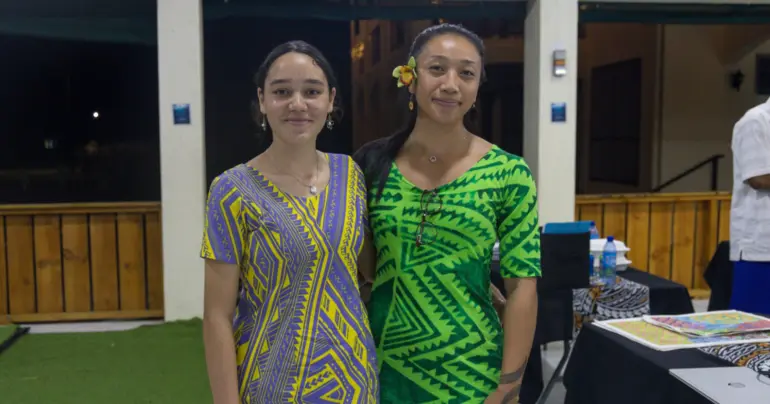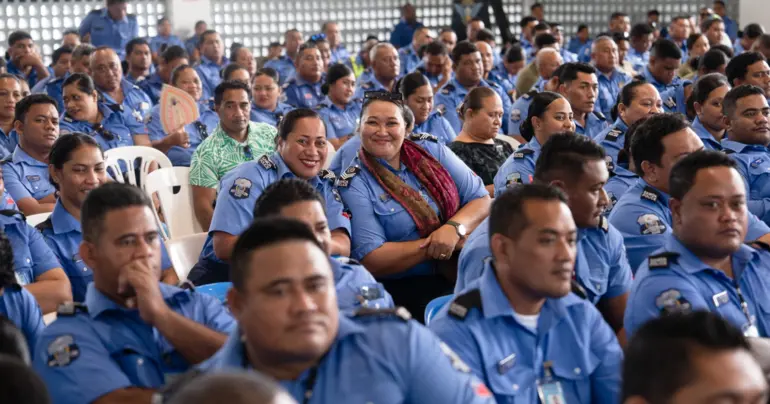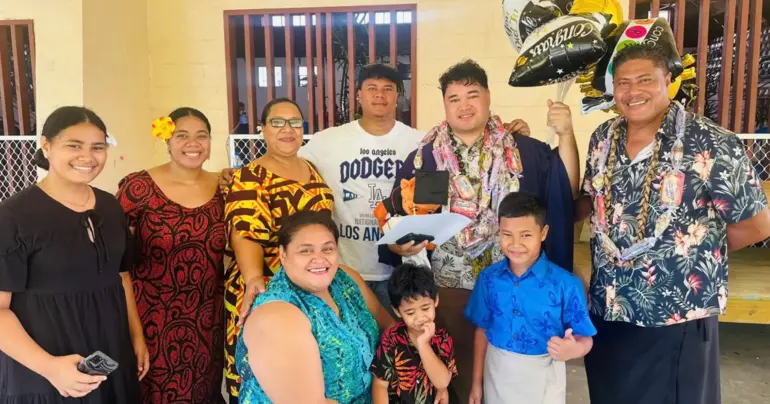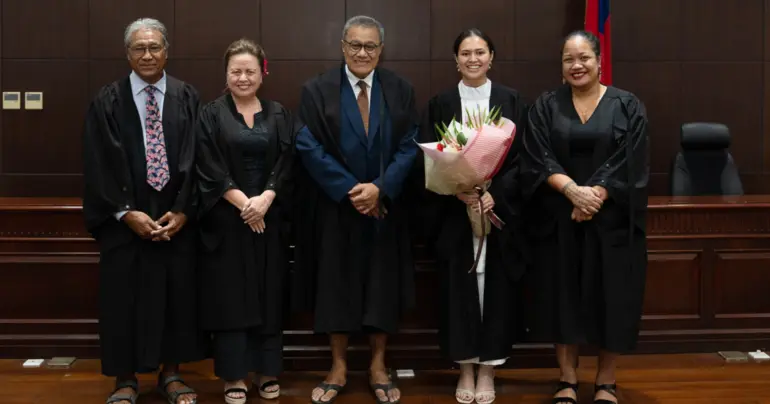Damage minimal, investigation finds
An explosion at one of the fuel tanks at the Matautu Wharf, which killed an employee of Petroleum Product Supplies Ltd earlier this year, caused “minimal impact” on the environment.
That’s the conclusion by a group tasked to investigate the environmental impact of the explosion, which caused nationwide panic and shut down the Apia Township in April this year.
The Environmental Audit Team included representatives from the Ministry of Natural, Resources and Environment (M.N.R.E.), Samoa Scientific Research Organisation (S.R.O.S.), Secretariat of the Pacific Regional Environment Programme (S.P.R.E.P.), Ministry of Finance (M.O.F.) and two private Civil Engineers.
According to a copy of their report addressed to the Disaster Advisory Committee (D.A.C.) obtained by the Samoa Observer, the group did not sight nor note by smell, the presence of any diesel spillage from the affected tank.
Although significant structural surface damage was visible around the tank, the group found that there was no “visible evidence of leakage to adjacent properties specifically the container yard to the east, west and southern boundaries and into the sea. The isolation valves were advised to be locked fully for the tank farm.”
The investigation then concluded that the damage to the environment was minimal.
“Having inspected the subject site as well as discussions made with the MoF representatives, the team is satisfied that the incident caused minimal environmental impacts to the environment and its adjacent surroundings,” the report found.
“It is recommended therefore that: No further environmental assessment is required of the subject site.”
On 4 April at 10am, there was an explosion at one of the diesel fuel storage tanks on the wharf at Matautu-tai.
The explosion triggered a fire, which was responded to within minutes by the Fire and Emergency Services Authority (F.E.S.A) personnel. Emergency workers immediately evacuated everyone within close proximity to the wharf.
One of two employees working on the storage tank at the time of the explosion died. The second employee was treated and discharged.
As a safety precaution, the main fuel terminal at Sogi was shut down immediately.
The main focus of the Emergency response team was to contain the fire and prevent it from spreading to the other two adjacent tanks.
Upon learning of the incident, Prime Minister, Tuilaepa Sailele Malielegaoi, led the coordination of the Disaster Advisory Committee at F.E.S.A headquarters and personally requested assistance from the Australian, New Zealand and United States Governments.
The memorandum from the inspection group to the D.A.C is published in full below:
TO: Disaster Advisory Committee (DAC)
FROM: Environmental Audit team
DATE: 7 April 2016
SUBJECT: Post Environmental Assessment of the Fuel Tank Fire on 04th April 2016.
1. Introduction
This report provides an assessment of possible environmental impacts caused by the Fuel Tank fire which resulted in a fatality and destroyed one of the fuel tanks at the Tank Farm facility located at the Apia Port. Recommendations are also provided in this report.
2. Background
A request was put forward by the DAC chaired by the CEO of MNRE on 5 April 2016 to investigate and confirm any environmental impacts resulting from the fuel tank storage fire that occurred on Monday 4th April 2016. The Environment Audit Team (“the team”) included 5 representatives of the MNRE, 1 from SPREP, 1 from SROS, and 2 civil engineer advisors.
As per the development consent approved by PUMA for the farm tank facility in 2012, the estimated cost of the facility was SAT$17,000,000.00. The construction works commenced in early 2013.
2.1 Legislative Framework
The following relevant legislations have been used in this assessment:
. a) Marine Pollution Prevention Act 2008;
. b) Lands, Survey and Environment Act 1989;
. c) Waste Management Act 2010; and
. d) Planning and Urban Management Act 2004.
2.2 Description of the Site and Surrounding Environment
The tank farm facility is located at Matautu-tai on government land within the Samoa Ports Authority (SPA) compound at the north eastern part of the port. However, the facility site is currently under the Ministry of Finance and is being operated by the Petroleum Products Supplies Ltd, a privately owned business. The facility is appropriately demarcated by a chain link fence and further fenced off with a cemented containment bund. The area of the subject site cannot be determined as it is yet to be surveyed. The eastern, western and southern boundaries are adjoined by the container yard under SPA while the northern boundary is adjacent to the sea. There are currently 2 fuel storage tanks to the east of the facility while the half burnt tank is located to the west.
3 Methodology
The team conducted a visual site inspection on Wednesday 6th April 2016. Two representatives (Peseta Konelio Tone and Chris Flannery)from the Ministry of Finance (MoF) who were involved in the construction and design of the facility were present on- site to assist the team with information on the operation andmanagement of the tank farm. Mr. Peseta Konelio also provided information on the procedures and actions that were completed during and immediately following the fire. The information provided by the site representatives have not been validated and is assumed to be correct.
4 Findings
The following captures the observations identified by the team during the visual site inspection:
4.1 Resources at risk:
4.1.1 Apia town area:
The Samoa bureau of statistics reported that the 2016 estimated population of Apia urban area is 35,762. The tank farm is located on the port and any effluent drain outlets are located adjacent to Palolo deep which is a marine protected area.
4.1.2 Mangroves and sea grass:
Mangrove and sea grass species are vulnerable to oil and oiling can cause widespread die back in mangrove and sea grass habitats and associated species. These habitats may take decades to recover. Mangroves and sea grass beds provide critical habitat for a range of fish and other species including recreational and commercially harvested fish species along with reptiles. Intertidal sea grass meadows are highly vulnerable to oil.
4.1.3 Corals: Corals are an essential and dominant part of coral reef communities, and play a key role in determining the composition and nature of reef systems. Shallow corals less than 10m in depth may be vulnerable to oil.
4.2 Sources of pollutants:
4.2.1 Diesel spillage and emissions:
1)We did not sight nor note by smell, the presence of any diesel spillage from the affected tank. Significant structural surface damage was visible around
There did not appear to be any visible evidence of leakage to adjacent properties specifically the container yard to the east, west and southern boundaries and into the sea. The
isolation valves were advised to be locked fully for the tank farm. 2
the top half of the affected tank outer shell.
. 2) The concrete bund and flooring surrounding the tanks appeared in satisfactory condition and is believed to have captured run-off fire water (potentially contaminated with paint) and directed it to the “separation tank”.
. 3) There was no visual evidence in the American Petroleum Industry (API) oil separator that firefighting water that accumulated within the bunded facility and subsequently discharged to the marine environment contained hydrocarbons.
. 4) There was no visual evidence of chemical and hazardous waste materials present on site. However, there were remnants of burnt paint contained within the concrete bund.
. 5) The volume of diesel combusted was 182 tonnes as per discussions with the on-site reps. There was no visual evidence of nearby Apia town residents affected by the fire emissions either from the volatile organic compounds.
. 6) It was noted that there was no Occupational Health and Safety (OHS) signs on site during the investigations.
4.2.2 Tank paint emissions:
We made inquiry regarding the specification of the tank paint whether it would contain any lead particulates. The MoF representative was asked to provide specification confirmation for the primer and finishing paints used to coat the exposed external tank walls. The size of the tank paint that combusted could not be confirmed during the inspection. Burnt paint ash has accumulated on the base of the containment bund.
4.2.3 Fire fighting foam (AFFF):
The volume of firefighting Aqueous Film Foaming Foam (AFFF) (Film Foam Fluro Protein (FFFP) used during the accident could not be confirmed on site. This foam is a protein based foam and is biodegradable and hence has no impact when released to the marine environment.
The team however raised concerns about the proposed decommissioning of the damaged fuel storage tank.
5 Recommendation(s)
Having inspected the subject site as well as discussions made with the MoF representatives, the team is satisfied that the incident caused minimal environmental impacts to the environment and its adjacent surroundings. It is recommended therefore that:
a) No further environmental assessment is required of the subject site.
. b) The burnt paint should be collected and disposed of at an appropriate disposal site. It should not be allowed to be discharged via the facilities stormwater management system that discharges to the sea.
. c) The Ministry of Finance to liaise with the MNRE and all relevant government entities prior to the decommissioning of the half burnt storage tank. A development consent shall be obtained prior to commencement of decommissioning activities.
. d) The specifications of the tank’s paint should be obtained to identify any hazardous waste implications.
. e) The availability of the PPS (or equivalent) Emergency Plan should be verified, both as a hard copy on site and availability to emergency services. This was not observed during the site visit.
. f) The volume of firefighting foam used on site needs to be confirmed.
6 Inspection Team
MNRE - Tauti Fuatino Leota, Faumuina Ferila Brown, Toai Bartley, Anna Blake, Jeffrey Faitua
SROS – Pousui Fiame Leo
SPREP - Anthony Talouli
MoF - Peseta Konelio Tone and Chris Flannery
Private Engineers (Apia Waterfront Project - MNRE/NZ High Com) - Vui Sebastian and Connon Andrews











